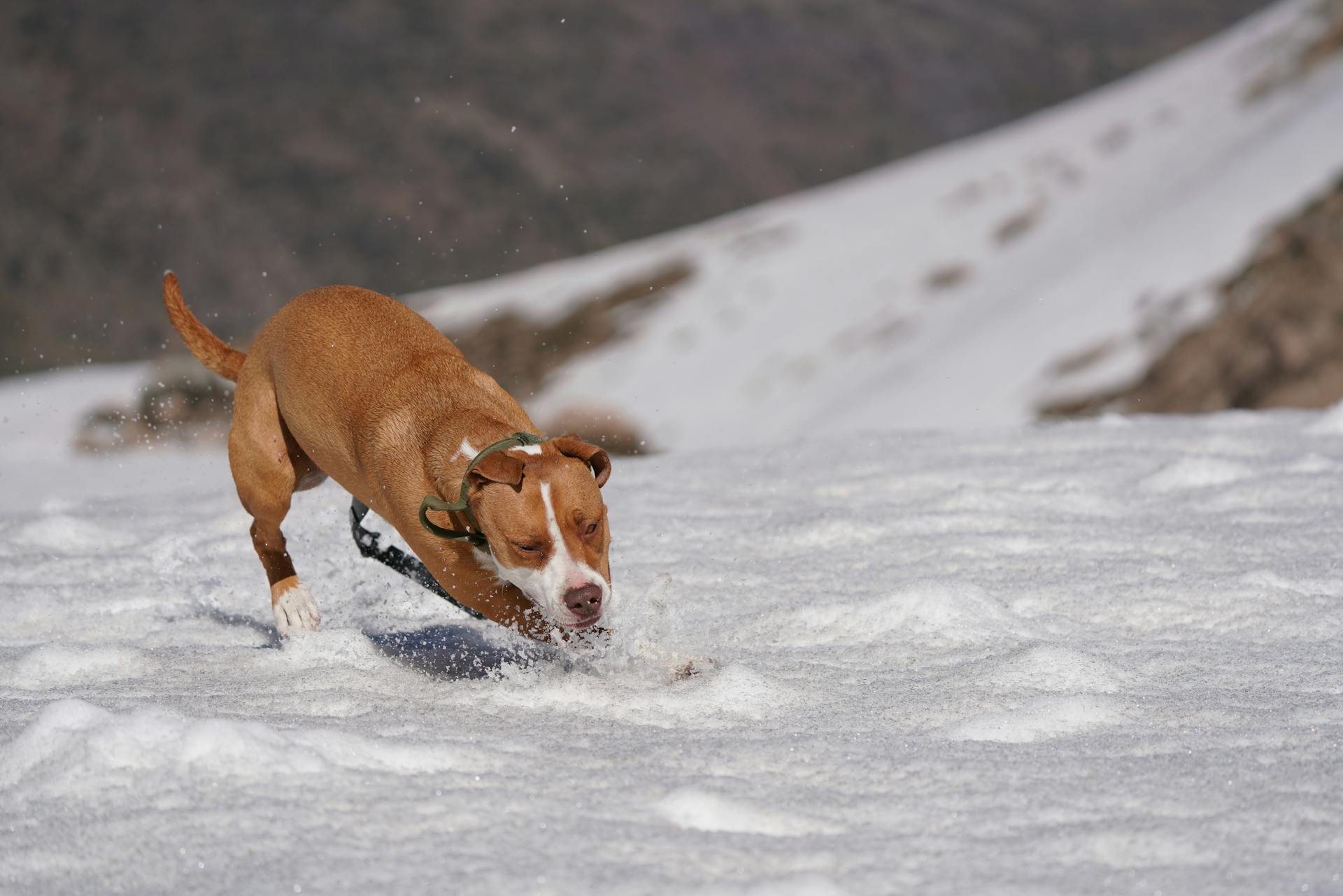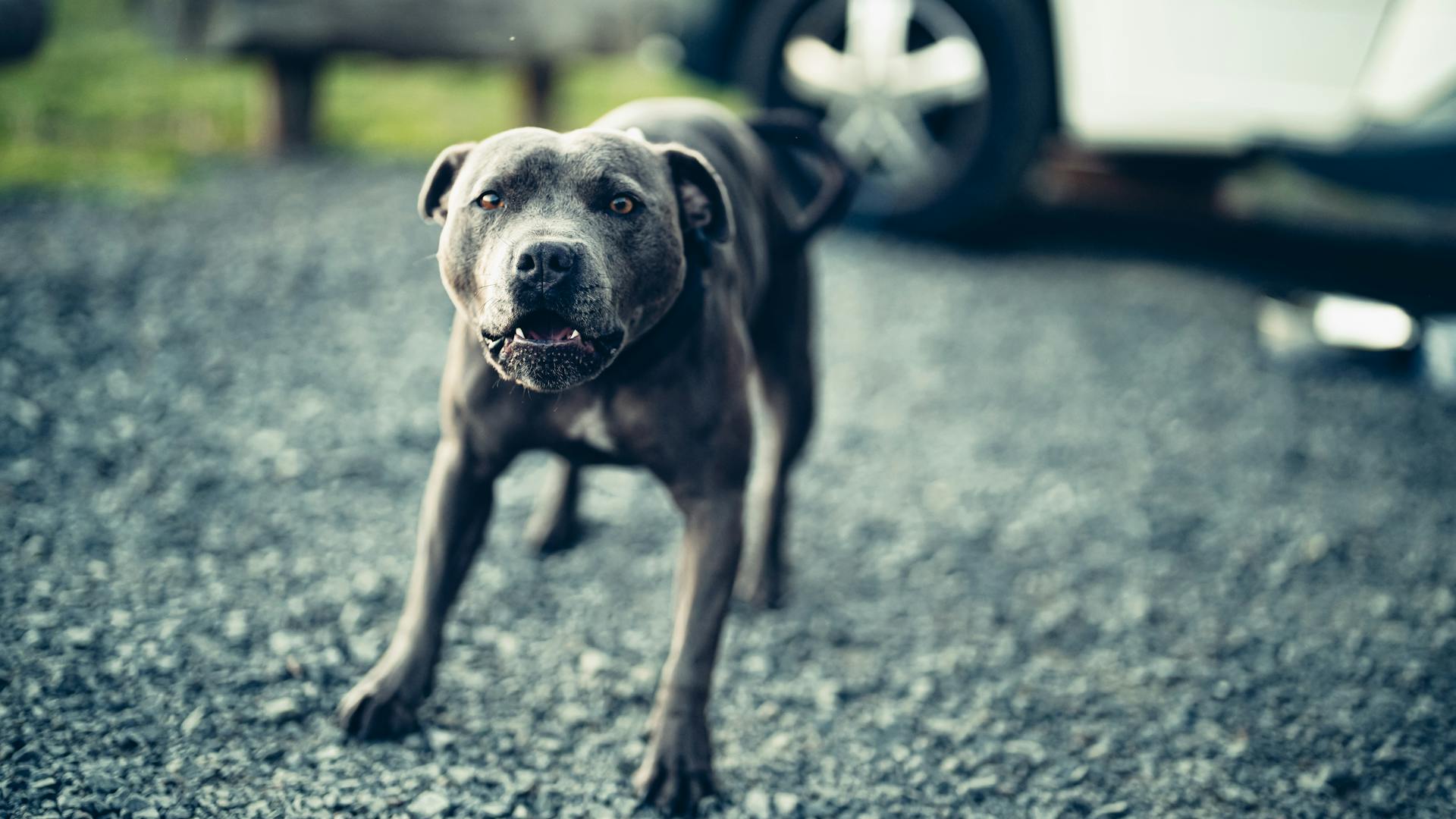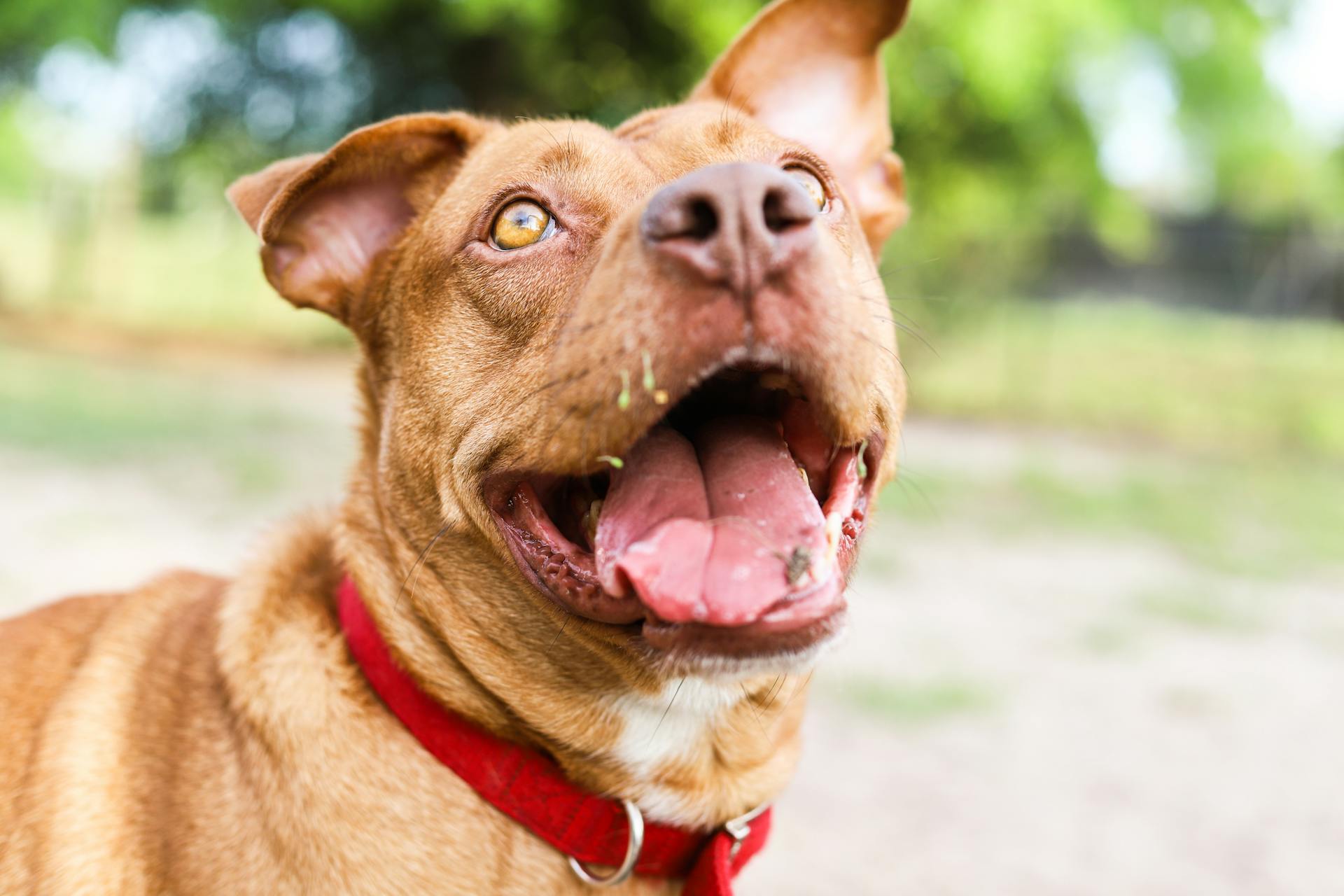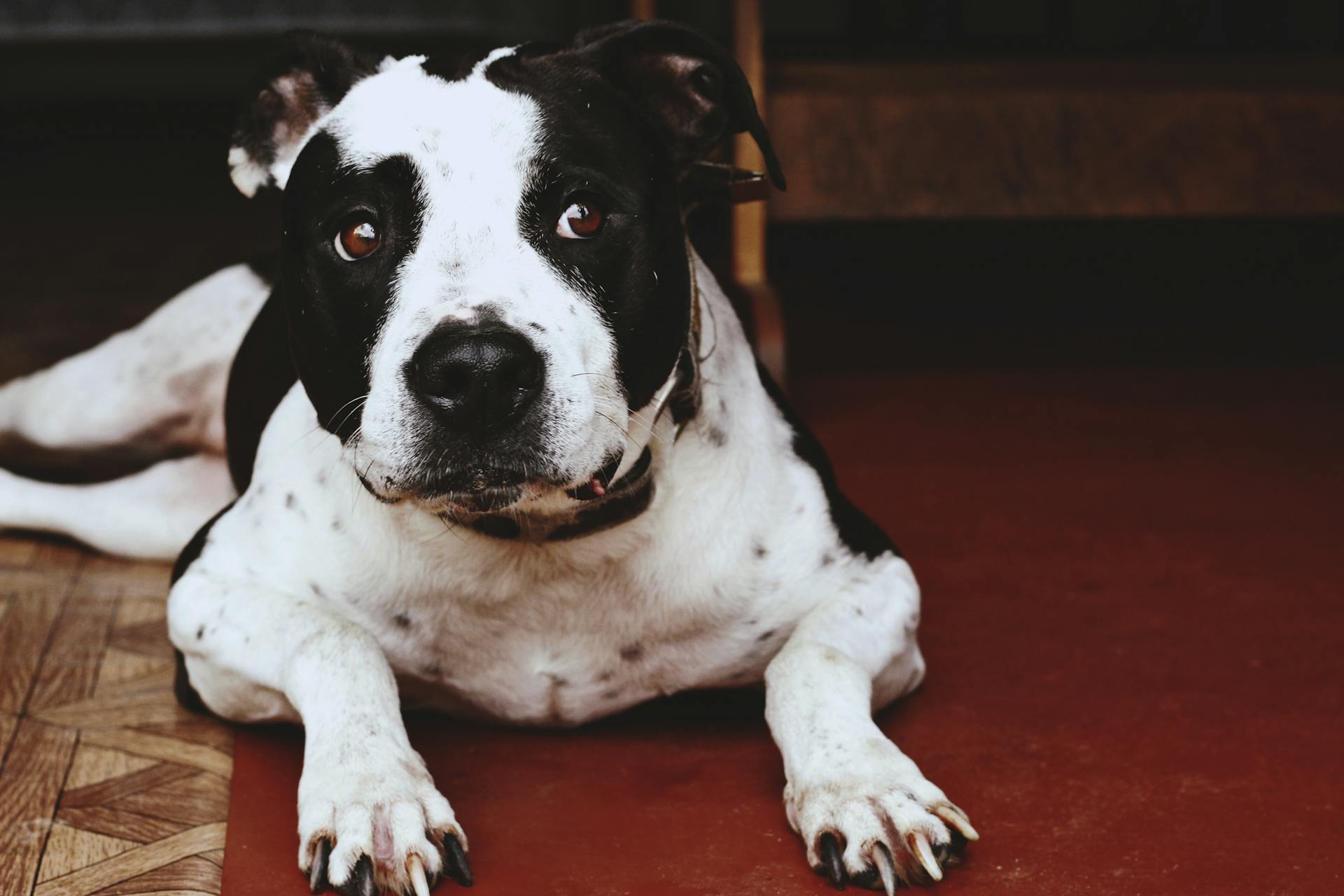
If you're considering bringing an APBT (American Pit Bull Terrier) into your family, it's essential to understand their unique needs and characteristics.
APBTs are a breed of dog that thrives on attention and interaction, requiring regular exercise and mental stimulation to prevent boredom and destructive behavior.
They are naturally energetic dogs, requiring at least 30 minutes of exercise per day, which can be a mix of physical and mental stimulation.
General Information
The American Pitbull Terrier, or Apbt, is a versatile breed.
They originated in England in the 19th century and were brought to the United States in the late 1800s.
Their original purpose was for bloodsports like bull-baiting and dog-fighting, but they've since become popular family pets.
Apbts are known for their loyalty and affection towards their families.
They are highly intelligent and trainable, but can be strong-willed at times.
Their short coats require minimal grooming, making them a great choice for busy owners.
Apbts are generally good with children, but proper socialization is crucial.
They are also relatively low-maintenance when it comes to exercise, requiring only moderate activity.
Apbts are prone to certain health issues, including hip dysplasia and allergies.
Their average lifespan is around 12-14 years with proper care.
Health Issues
Pitbulls are prone to certain health issues, such as torn ACLs, which can occur due to their love of playfulness and high energy levels. The CCL, or canine equivalent of a human ACL, is a thin connective tissue in the knee that connects the femur to the tibia.
Regular wear and tear on the knee, loss of muscle strength in the hind legs, and abnormal bends at the knee joint can also put your pitbull at risk of developing a CCL tear. Most partial tears become complete tears due to continued physical activities.
Canine hip dysplasia is another common issue in pitbulls, and it can be treated with either surgery or non-invasive care. Surgery can be costly, starting at $1,700, and has risks, especially for older dogs or those with other health conditions.
Allergies
Allergies can be a real challenge for pets, especially dogs. In dogs, allergies make their skin itchy, a condition known as atopy. Pit Bulls often suffer from atopy, which can be a lifelong issue.
Symptoms of atopy typically start between the ages of one and three, and can worsen every year. Commonly affected areas include the feet, belly, folds of the skin, and ears. Licking the paws, rubbing the face, and frequent ear infections are common signs of atopy in dogs.
Torn CCL Treatment
Pitbulls with a torn CCL often require treatment to alleviate pain and promote healing. In many cases, non-invasive options can be just as effective as surgery.
Acupuncture, massage therapy, and supplements are all viable treatment options for a torn CCL. Red light and/or cold laser therapy, canine chiropractic, and water therapy can also provide relief.
The success of any treatment option depends on the age, health, and activity level of the dog. A dog knee brace, like Ortho Dog's cruciate care knee brace, can stabilize the knee to reduce pain and inflammation during healing.
In 60% of cases, a dog with a torn ACL will later injure the other knee. Bracing the injured knee can take pressure off the other leg, hopefully avoiding injury to that leg.
Check this out: Are Therapy Dogs Service Animals
Infections
American Pit Bull Terriers are susceptible to bacterial and viral infections, just like any other dog.
Parvo, rabies, and distemper are just a few examples of the infections they can get.
These infections are often preventable through vaccination, which is recommended based on the diseases prevalent in the area, the dog's age, and other factors.
Regular vaccinations can go a long way in keeping your Pit Bull healthy and protected.
Infections can be serious and even life-threatening if left untreated, so it's essential to stay on top of your dog's vaccination schedule.
By taking proactive steps, you can help prevent infections and keep your Pit Bull happy and healthy.
Care and Lifestyle
Caring for your American Pit Bull Terrier (APBT) is a big responsibility, but with the right routine, you can keep your furry friend happy and healthy. Supervise your pet as you would a toddler, keeping doors closed and picking up after yourself to prevent mischief.
APBTs have relatively low grooming needs, but regular brushing is essential. Brush your APBT's coat at least weekly, and their teeth at least twice a week to keep them perfect. Cleaning their ears weekly is also crucial, even from a young age.
A consistent diet is vital for your APBT's health. Feed a high-quality diet appropriate for their age, and avoid giving them people food. Exercise your dog regularly, but don't overdo it at first to prevent boredom and potential behavioral issues.
Recommended read: Why Does My Male Dog Keep Licking My Female Dog
Care and Lifestyle

Taking care of your American Pit Bull Terrier is a big responsibility, but with the right routine, you can help her live a happy and healthy life.
Watch her diet closely, making sure she gets plenty of exercise and regular check-ups with her vet. This includes brushing her teeth and coat, and cleaning her ears weekly.
Supervising your pet is crucial, especially in the early stages. Keep doors closed, pick up after yourself, and block off rooms as necessary to prevent her from getting into trouble.
A proper diet is essential for your Pit's overall health. Feed her a high-quality diet appropriate for her age, and avoid giving her people food.
Here's a quick rundown of your Pit's grooming needs:
- Brush her coat at least weekly
- Brush her teeth at least twice a week
- Clean her ears weekly
Exercise is also vital for your Pit's physical and mental well-being. Regular exercise will keep her mind and body active, preventing boredom and naughty behavior.
With consistent exercise and training, your Pit can become a well-behaved and loyal companion. Remember, early obedience and socialization are key to preventing overprotectiveness and aggression.
Getting Started in Sports

Getting started in dog sports can be an exciting and rewarding experience for you and your furry friend. If you're new to dog sports, start by learning about the basics with an intro to dog sports.
You can also consider enrolling your mixed-breed dog in a canine partners program, which is a great way to get started. Many organizations offer these programs, and they're a fantastic way to socialize your dog and learn new skills.
Titles and abbreviations can be confusing, but don't worry, you'll get the hang of it. Familiarize yourself with common titles and abbreviations used in dog sports to make the most of your experience.
If you're unsure which sport to try with your dog, there are several options to consider. From agility to obedience, there's a sport out there for every dog and owner.
To get started in dog training, you'll need to find a qualified instructor or training program. Look for programs that use positive reinforcement techniques and are tailored to your dog's needs and level of experience.
Virtual dog sports and events are becoming increasingly popular, offering a convenient and accessible way to participate in dog sports from the comfort of your own home.
A unique perspective: All about Dogs Dog Training
Genetic Predispositions
Hip dysplasia is a common inherited disease in American Pit Bull Terriers that causes the hip joints to form improperly, leading to arthritis.
You may notice your dog has lameness in his hind legs or difficulty getting up from lying down, which can be a sign of hip dysplasia.
Overweight dogs are more likely to develop arthritis years earlier than those of normal weight, causing undue pain and suffering.
Surgery is sometimes considered in severe and life-limiting cases of hip dysplasia.
Staffordshire and Breeding
Staffordshire Bull Terriers were originally bred in the mid-19th century in the West Midlands region of England, specifically in Staffordshire.
Their breeding was influenced by the Old English Bulldog and the Old English Terrier, resulting in a unique combination of strength, agility, and affectionate nature.
The breed was initially developed for bloodsports such as bull-baiting, but after this practice was outlawed in 1835, they became popular companions and family pets.
Today, Staffordshire Bull Terriers are known for their gentle and even-tempered nature, making them an excellent choice for families with children.
Frequently Asked Questions
What is the difference between a pitbull and an APBT?
The American Pit Bull Terrier (APBT) is a specific breed, while the term "pitbull" is often used to refer to a broader category of dogs that may include several breeds. The distinction between the two terms is often a matter of debate among breeders and experts.
What breeds make an APBT?
The American Pit Bull Terrier (APBT) is a specific breed that originated from Bull-and-Terrier type dogs used for dog fighting. It is one of the breeds included in the technical definition of "pit bull
Is APBT high energy?
Yes, American Pitbull Terriers (APBT) are a high-energy breed that requires regular exercise to stay happy and healthy. Regular physical activity is essential to channel their energy positively.
What are APBT used for?
American Pit Bull Terriers were originally bred for tasks like herding, hunting, and guarding, but their primary purpose is as loving companions. They excel in roles that value loyalty and affection.
Sources
- https://www.lombardvet.com/services/dogs/breeds/american-pitbull-terrier
- https://www.advancedanimalcare.com/services/dogs/breeds/american-pitbull-terrier
- https://www.noahsarkvet.com/ervices/dogs/breeds/american-pitbull-terrier
- https://www.akc.org/dog-breeds/american-staffordshire-terrier/
- https://orthodog.com/article/pitbull-hip-hind-leg-problems/
Featured Images: pexels.com

